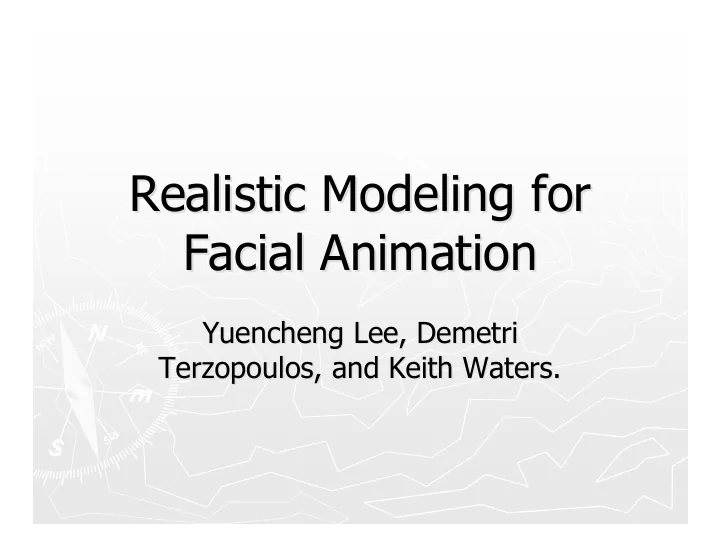

Realistic Modeling for Realistic Modeling for Facial Animation Facial Animation Yuencheng Lee, Lee, Demetri Demetri Yuencheng Terzopoulos, and Keith Waters. , and Keith Waters. Terzopoulos
Overview Overview Desire ► Desire ß A realistic model of a human face that can A realistic model of a human face that can ß be easily animated. be easily animated. Problem ► Problem ß Creating facial animation models is tedious Creating facial animation models is tedious ß and cumbersome, requiring a great deal of and cumbersome, requiring a great deal of user input. user input. Solution ► Solution ß Automate it! Automate it! ß
Method Method Two-part Approach ► Two-part Approach ß Adapt a generic face mesh to range and Adapt a generic face mesh to range and ß reflectance data. reflectance data. Find the facial features from scanner input. ► Find the facial features from scanner input. Map it to the generic face mesh. ► Map it to the generic face mesh. ß Extend the mesh to a functional physics- Extend the mesh to a functional physics- ß based model capable of facial expression. based model capable of facial expression.
Image Processing Image Processing ► Input: Range & Reflectance Scan Input: Range & Reflectance Scan Acquired from cylindrical scanner. Acquired from cylindrical scanner. ß ß Problem: Laser disperses in places such as hair and chin. Problem: Laser disperses in places such as hair and chin. ß ß Solution: Interpolate the values from nearest neighbors. Solution: Interpolate the values from nearest neighbors. ß ß This still leads to awkward hair representations (shown later). This still leads to awkward hair representations (shown later). ß ß
Generic Mesh Adaptation Generic Mesh Adaptation ► Get a cylindrical representation of the generic Get a cylindrical representation of the generic facial mesh, then map it to the LaPlacian LaPlacian field field facial mesh, then map it to the of the range data. of the range data. ► Match features corresponding to the dark Match features corresponding to the dark lines: lines:
“Heidi Heidi” ” Example Example “
Estimating “ “Relaxed Relaxed” ” Model Model Estimating ► Optimal facial expression is a neutral one. Optimal facial expression is a neutral one. ► “ “Heidi Heidi” ” is smiling with her mouth open, how do is smiling with her mouth open, how do we get the relaxed model? we get the relaxed model? ß Map the mesh without Map the mesh without ß locating the mouth locating the mouth contour, then adjust the contour, then adjust the mesh back to the neutral mesh back to the neutral position. position. ß But how does the algorithm know which feature to But how does the algorithm know which feature to ß ignore? ignore?
The Dynamic Skin & Muscle Model The Dynamic Skin & Muscle Model ► Faces on the mesh are complex models of Faces on the mesh are complex models of human tissue. human tissue. ► Tissue and muscle forces are modeled Tissue and muscle forces are modeled properly so one that movement propagates properly so one that movement propagates correctly throughout the face. correctly throughout the face.
Skin Incompressibility & Skull Skin Incompressibility & Skull Deformation Constraint Deformation Constraint ► Skin is incompressible, so a constraint is used to ensure Skin is incompressible, so a constraint is used to ensure the skin volume doesn’ ’t magically increase or t magically increase or the skin volume doesn decrease. decrease. ► An important addition to the physical model is a An important addition to the physical model is a constraint to prevent skin from penetrating the skull. constraint to prevent skin from penetrating the skull.
Other Head Components Other Head Components ► Eyes, Eyelids, Teeth, Hair, Neck, and Bust are Eyes, Eyelids, Teeth, Hair, Neck, and Bust are all added to the final geometric model. all added to the final geometric model. ß Eyelid texture is synthesized based on the Eyelid texture is synthesized based on the ß interpolation algorithm from earlier. interpolation algorithm from earlier.
Results Results
Results Results
Questions? Questions?
Recommend
More recommend